It’s one thing to win at Bathurst, yet quite another to be first across the finish line after what many rate as the hardest battle around the mountain of all time. By the time the chequered flag came down on the 1972 Australian Senior & Unlimited Tourist Trophy, Ginger Molloy and Bill Horsman shared a new lap record, and had been the main players in a race that would be remembered as one of the best.
Molloy had finished second to Giacomo Agostini in the 1970 World 500cc championship and enjoyed a fruitful season racing in the USA in ’71. But even after eight years in the Continental Circus the tough Kiwi was by no means done. As he proved when he won the Lightweight TT on his methanol-burning Yamaha TD3 that Easter weekend in 1972 – on his very first trip to Mount Panorama.
Molloy’s mount for the combined Australian Senior & Unlimited TT was his super-fast Kawasaki H1R 500cc racer, his second such H1R triple, which still resides in Australia. The two classes were combined, although you had to enter both categories if you wanted the title – and the prize money.
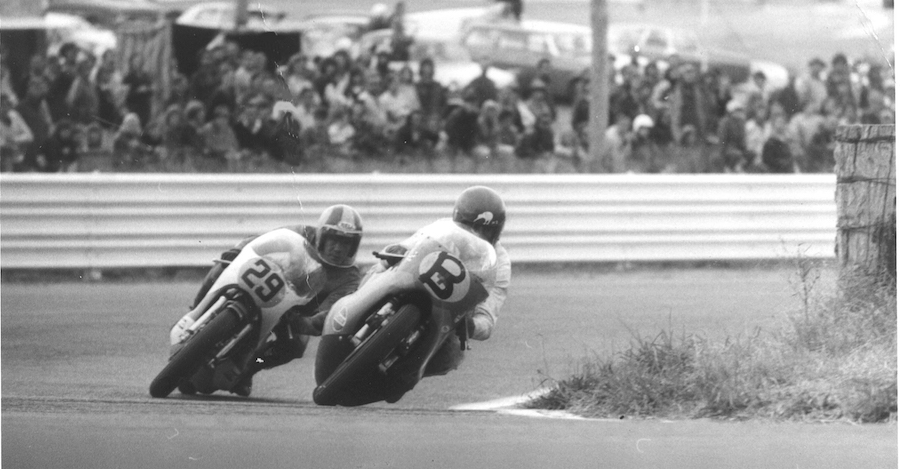
On the other side of the grid, Horsman was a highly successful racer with a proven background. The previous month the South Australian had enjoyed a clean sweep at Symmons Plains in Tasmania by winning the Australian Junior, Senior and the Unlimited Grands Prix.
Horsman fired the opening salvo at Bathurst by winning the Junior TT (350cc), setting a new class lap record in the process. His weapon of choice was a trick Yamaha TR2, though both riders agree that Molloy’s bike was some 10mph (16km/h) faster down Conrod Straight than the smaller 350cc Yamaha.
Despite the obvious talent of both men, it could be argued a large part of the premier result came down to machine preparation. The newly released TR3 was still on order for Horsman, and the Adelaide motorcycle mechanic was aware of a common problem with the outgoing models. He cobbled together a TR2 and a TR2B for the Bathurst meeting.
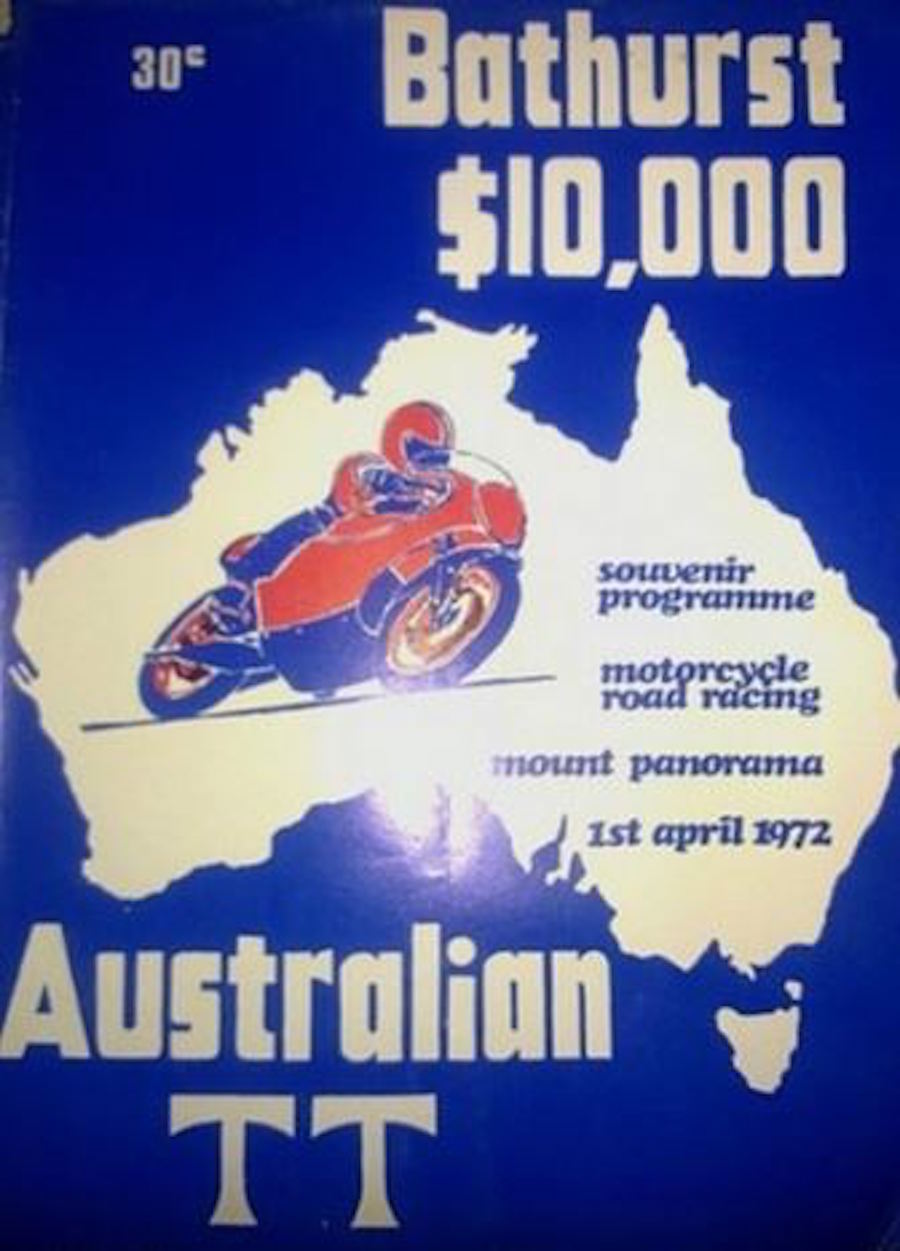
“The TR2s ran big-end bearings, and the TR2Bs broke conrods, so we used TR2 rods and TR2B big ends,” Horsman remembers. “We built one up using a combination of both and we never had any trouble. We tried to keep them as standard as possible and put them together well. We spent a lot of time making sure everything spun freely and was all central and stuff like that. I believe a lot of the secret was in the TR crankcases. If you had a good one where the bearing housings and the bearings were compatible, a good nip fit, you had a nice smooth bike.”
Molloy mostly kept his H1R in standard trim, although for Bathurst he’d come up with a unique solution for the seizure-prone conrods and big ends, employing his Australian friend Bert Flood to make new crankpins and interchange parts with Yamaha TR3 components.
“I geared it down and down, and we levelled it at 11,500 revs,” Molloy recalls. “With the small TR3 crankpins you could really rev it. Before then it was 9500rpm! It did 173mph (278km/h) down the end of Conrod Straight.”
Knowing how important it was to have top-notch brakes at Bathurst, Molloy bought new parts in NZ to run twin discs on his H1R but didn’t have time to test them, which may have cost him the race.
“I didn’t know anything about disc brakes except that they worked. 750 Hondas had a single disc on the front so I bought a hub, another disc and a master cylinder, and Les Delay fitted them, but unfortunately I didn’t get to try it. So at Bathurst on the first lap – what a disaster the front brake was, because it didn’t work! Well, it worked, but it had a big piston in the master cylinder, when it should have had a small piston, but I just didn’t know anything about that then.”
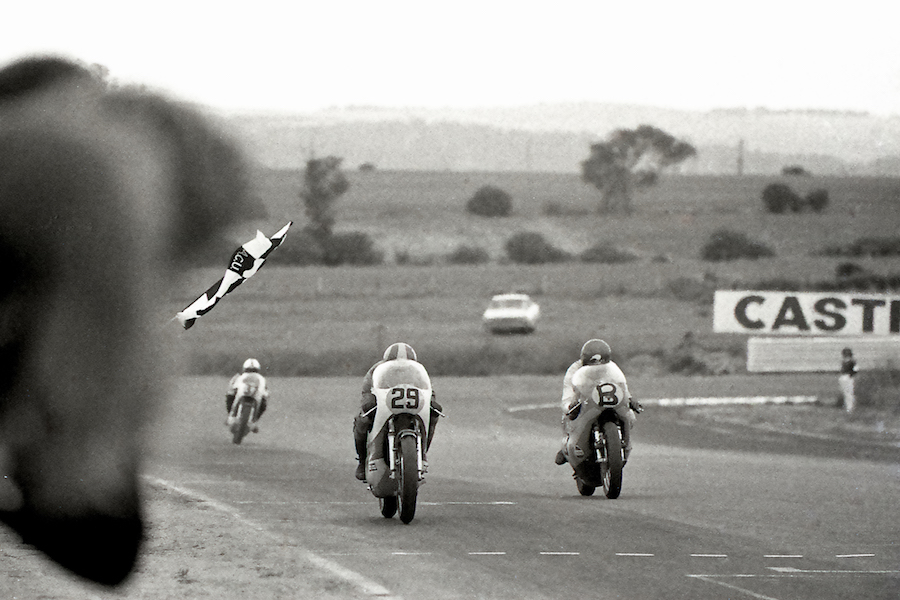
The 25,000 fans on race day were in for the treat of their lives. There was a mix of old and new bikes on the grid, plus a few specials. Eric Hinton had a home-built Yamaha 500cc triple with 120º crank intervals, modified from a Yamaha 350. Unfortunately the clutch failed on the opening lap. Rob Hinton had a 350 Yamaha bored out to 460cc, making about 52kW.
When the Senior & Unlimited TT got underway, Tony Hatton led the opening two laps on a Yamaha R5 350 before the charging trio of Molloy, Bryan Hindle and Horsman took over. It was still tight, with up to eight riders battling for the lead during the first half-dozen laps. Barry Rattray, Sid Lawrence and Les Kenny – all on Yamahas – plus Rob Madden on a Kawasaki triple firing into the circuit’s unforgiving corners side by side.
Horsman made it to the front but still had the wily international Molloy hot on his tail. On the ninth lap Molloy took the lead heading up Mountain Straight, but it didn’t last long as Horsman had other ideas approaching the top of the mountain. The Kiwi then struck back, powering his fast Kawasaki ahead again going down Conrod.
Molloy had the horsepower but Horsman had the handling and better brakes.
“Bill could always pass me over the top of the mountain,” Molloy says.
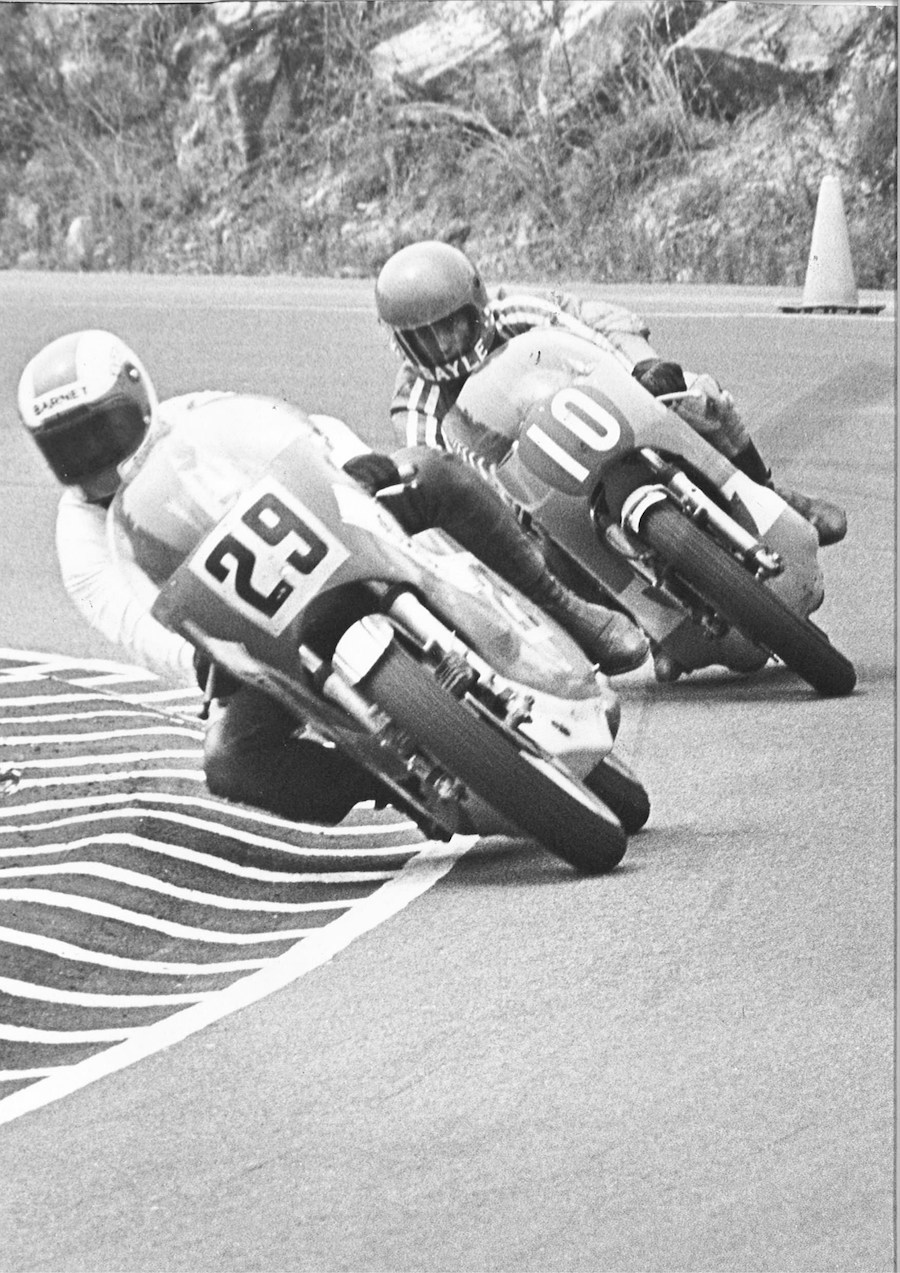
“I have vivid memories of that race,” Horsman says. “I could close on Ginger going up the hill out of the Cutting. As good a rider as he was, he just couldn’t get his bike around the Cutting anywhere near as quick as my TR2B would go around there. Consequently, going up that hill my bike would close on him; I’d be literally on his back wheel as we went over the top onto McPhillamy Park.
“Each time he would pass me going down Conrod Straight – and that was in the days when it was one long straight, with no Chase in it, but with the ‘jump’ at the end. I was going down the middle of the road and Ginger would go down the right-hand side, which was the expected thing; just by what used to be the drive-in theatre, the road was very, very rough and patchy-bumpy, and I can still see him standing up on the footrests with that thing shaking its head and the back wheel bouncing all over the road. Each time I was thinking to myself, ‘Better you than me, Ginger!’”
Molloy, who was wearing his famous white leathers, recalls: “It was leaping and bounding and going crazy over those two jumps on Conrod. Everything was getting in the air, it was wobbling and weaving, it was just dangerous – I couldn’t hold it full bore!”
“Ginger’s Kwaka just had too much horsepower,” Horsman says. “I think it had a hinge in the middle of the frame! The TR2B was a lot quicker and steadier over the top of the mountain; he was quicker down the straight, but I wouldn’t want to be on that thing going over those bumps! Man alive, I took my hat off to him each time.”
At Skyline, Horsman’s better-handling TR2B would grab the lead again.
“He passed me every lap at Skyline, including the last lap – he was too fast there and through the following bends,” Molloy says. “The corner before Skyline is a left-hand sweeper (McPhillamy Park). I tried extraordinarily hard and there was just no way I could beat Bill Horsman over Skyline. He braked much later than me, then disappeared down to the Dipper and went onto Conrod Straight about 50 to 100 yards in front of me.”

“I’m not saying my idea was right,” says Horsman, “but I used to go around McPhillamy using all the road but stayed on the right-hand side of the road going over Skyline. So I used to go straight over and straighten out the right-left hand kink as much as possible. The only other bloke that I found that did the same as me was Len Atlee. Everybody else moved to the left-hand side of the road and made a substantial bend of the left-hand kink, after the right-hand bit over the top.”
The battle raged in a similar vein for the next 20 minutes as the pair swapped places and paint. Horsman remained confident.
“I’d pass Ginger over the top and he’d pass me down Conrod Straight (but) I tried to do as much as I could so he would pass me later and later going down the straight. So each lap I was trying to get another couple of yards.
“I was thinking to myself, ‘If there’s enough laps I’ll get to the line and he won’t have caught me!” Horsman says, laughing. “He’d catch me the first time at the top of the first hill on Conrod, and towards the end he’d pass me before the second jump, at the bottom of the dip where you go up the rise and then into Murrays.”
By now the crowd was going wild and were cheering both riders on for the inevitable last lap showdown. Would it be the local Australian or the former Bultaco works rider who took honours? South Australia vs New Zealand, Yamaha vs Kawasaki… it had all the makings of a photo finish.
On the final lap Molloy charged down Conrod for all he was worth and left his braking to the very last moment to prevent Horsman’s lighter Yamaha from making a pass into Murray’s Corner, since Bill was barely 10 metres behind. But Ginger’s new twin discs were not up to the job. Molloy went one side of a lapped rider, Horsman the other.
“He passed me at the bottom of the second dip so we went over the jump together and he pulled away because of the extra speed of his bike,” says Horsman. “He didn’t get that much on me, I’d say maybe three bike lengths, but because of his extra speed and the extra weight of the bike, he had to get on the brakes earlier.”
“On the last lap I did the two jumps as fast as I could and I was still getting into tremendous trouble,” Ginger recounts. “In the braking area I went down the left-hand side of the road into the final corner and was ready to peel off when I heard this bike behind crashing through the gears.”
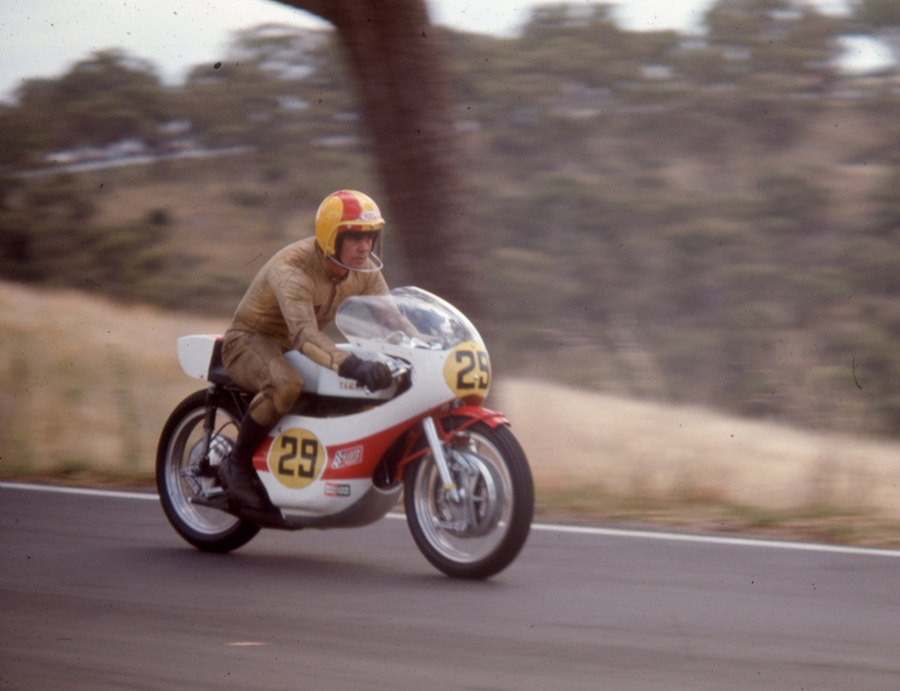
Indeed, Horsman had the front wheel skipping badly as he struggled to slow his Yamaha in time to make Murray’s.
“It was touch and go,” Horsman confirms. “The front brake was basically locked and it was skipping along the road and jumping off the ground then going back down. I knew that I could stop, as while it was doing that it was okay.”
“I thought, ‘Bill’s lost it,’ and I momentarily lifted and he managed to slip underneath,” Molloy says. “If I hadn’t have lifted he would have crashed right into the back of me.”
Even the crowd thought Horsman had too much speed on; however, the South Australian made the corner with a big slide to put the TR2B hybrid in front.
“We went into the corner together but I was in front,” remembers Horsman, “and then I accelerated to the line.”
He won with an official margin of 0.2sec, although Ginger still reckons he was only the thickness of paint behind.
Hindle completed the podium.
The crowd went mad and the struggle between the two goliaths would go down in Bathurst history as one of the best races of all time.
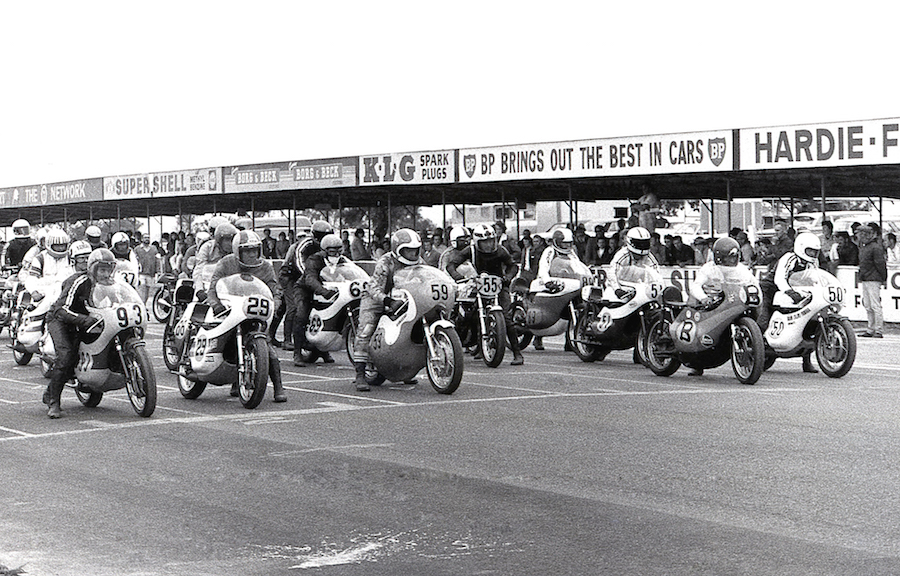
SHOW ME THE MONEY!
Horsman showed true commitment to competing at Bathurst by driving there knowing he didn’t have enough money to return home! How many in the sport today would do the same? Although Horsman doubled his prizemoney in one race because the Senior and Unlimited races were combined, the payout was not in cash.
“I went home with a bit of a story,” he recalls. “My finances were such that when I left home I didn’t have enough money to get back. I thought that everything should go alright, but if the worst came to the worst, I could get a job in Bathurst for a week or two, get a few quid to pay for the petrol and get home.
“As it turned out I had a very good day, but they paid in cheques, and nobody would cash the cheques! I was going around trying to cash a cheque to pay for the petrol to get home.
“In the end, I had a new triangular Dunlop front tyre that I sold to Ron Angel, who paid $100 for it, which got me the petrol to get home,” Bill says, laughing.
“If it wasn’t for Ron Angel I might have finished up living in Bathurst!”

WORDS – TERRY STEVENSON
PHOTOGRAPHY GINGER MOLLOY ALBUM, AMCN ARCHIVES, JIM SCAYSBROOK ARCHIVES & STEVE GREEN











